Chaga Mushroom Benefits And Uses (Complete Guide)
Contents
- What is Chaga Mushroom?
- How Chaga Works: The Key Compounds and Actions
- Chaga Mushroom Benefits
- Is Chaga a "Superfood?"
- How Chaga Mushroom Grows
- What Are the Side Effects of Chaga?
- How to Harvest and Prepare Chaga Mushrooms
- Chaga Mushroom for Sale: How to Choose a Chaga Supplement
- Using Chaga Supplements for Health
- Chaga Mushroom Recipes: How to Eat Chaga
- Feel the Chaga Mushroom Difference
Chaga is a unique medicinal mushroom used for centuries by cultures around the world as a remedy for a wide range of ailments*.
With a nickname like the “king of mushrooms,” Chaga has a lot to live up to. Historical and modern anecdotes abound claiming this mushroom can boost immunity, prevent cell damage, reduce inflammation, promote healthy skin and soothe digestive conditions*.
How did a weird mushroom (that essentially grows inside-out) get these superpowers? The answer is downright fascinating— but it can be complex, so we combed through the science and broke it down for you to share everything you need to know about chaga mushrooms.
What is Chaga Mushroom?
The scientific name for Chaga, Inonotus obliquus, means “to penetrate at an angle.” It’s an apt designation for a fungi that grows at a 20 to 30-degree angle relative to the surface of the trees it infects.
Yes, believe it or not, Chaga mushroom is actually a tree disease. Instead of growing on dead or dying wood, this member of the Hymenochaetaceae family of fungi[1] makes itself at home on live trees and behaves like a parasite throughout its lifecycle.
Most of this activity goes on underneath the tree bark where the fruiting body hides out.
The part of Chaga that emerges from the tree contains a combination of mycelium and wood and holds a reserve of food for the mushroom.
Called a sclerotium, this dark mass has earned Chaga such designations as:
It’s also called Kabanoanatake in Japan and either Bai Hua Rong or Hua Jie Kong Jun in China!
Chaga mushroom sclerotia are most often found on birch trees in cold climates throughout the Northern hemisphere, including Eastern Europe, Russia, Northeastern China and the northeastern U.S.
Occasionally, it may also be spotted on alder, spruce, beech, oak or poplar trees in these regions.
What Chaga Looks Like
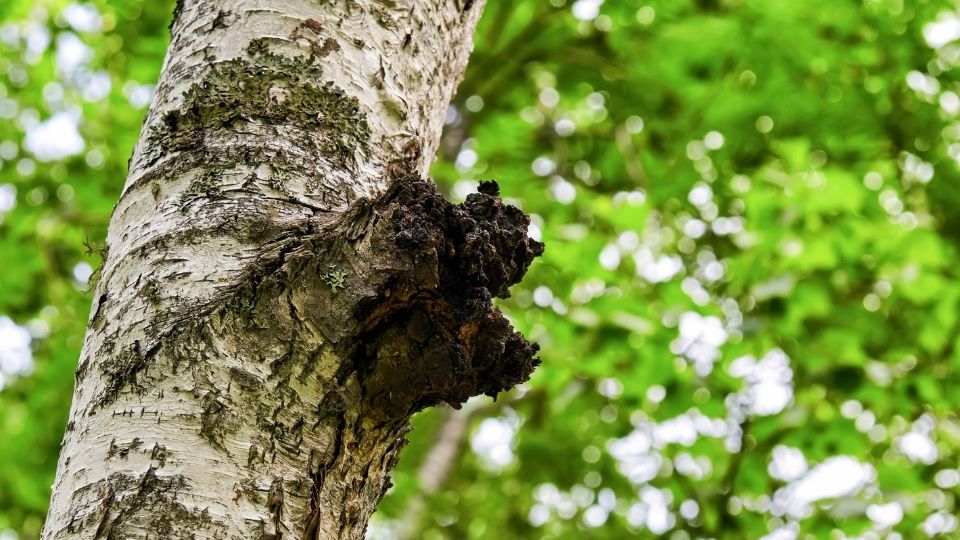
When compared to other medicinal mushrooms, Chaga is in a category of its own. Although technically a bracket fungus, it lacks the “shelf” shape characteristic of other mushrooms in this group, such as turkey tail and reishi. Instead, the sclerotium is more like a conk than a bracket and appears as a large dark blob emerging from the bark of infected trees.
It’s easy to spot because it even looks a bit parasitic, although it can be mistaken for rot or a tree burl at first glance.
What distinguishes Chaga mushroom from other tree diseases and deformities?
The exterior of the mycelium mass ranges from brown to black in color, but breaking off a hunk reveals an almost orange interior shade.
The sclerotia may be up to 48 centimeters (around 19 inches) in height and protrude from trees as much as 30 centimeters (just shy of 12 inches)!
History and Use
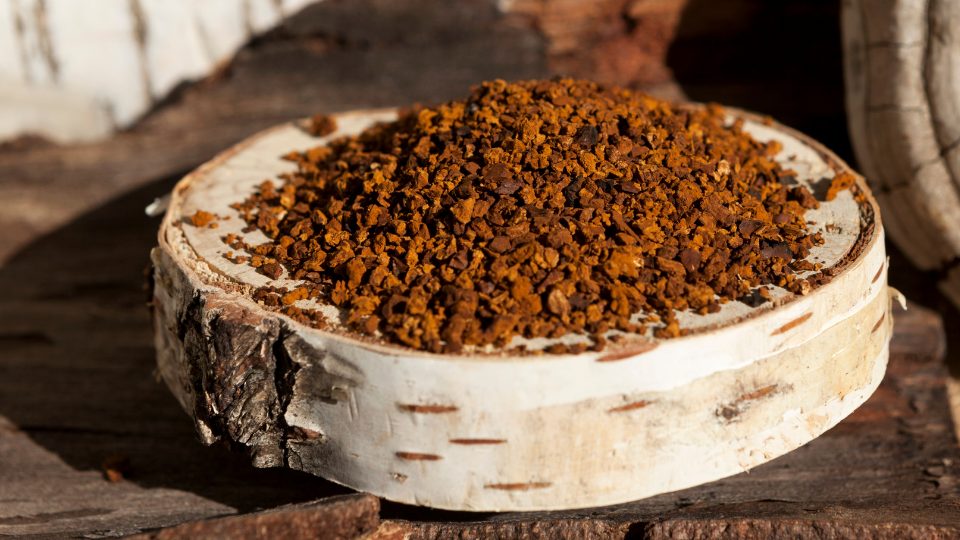
Chaga’s medicinal mushroom roots reach back into the histories of a diverse range of indigenous people around the world.
Some early records suggest it may have been used in ancient Rome, but most of what’s known about the mushroom’s cultural role comes from Eastern European, Russian and Native American sources.
Chaga in Russia and Siberia
Early records show the Khanty people in Russia and western Siberia relied on Chaga for natural healing as far back as the 1200s. In addition to medicinal uses, the mushroom also appeared in cleansing rituals.
In Russia and Slavic countries, the mushroom has long been used as a folk remedy for just about every conceivable ailment, including skin diseases and lung problems*.[4]
People across Siberia have also turned to Inonotus obliquus to address liver conditions, stomach disorders and even tuberculosis*.
Native American Chaga Mushroom Use
For indigenous populations across northern Canada, chaga held a special place in mythology, ritual and medicine.
The Cree, Ojibway and Denesuline people used the mushroom to address multiple ailments—including pain—and burned it to produce a sweet smell during pipe ceremonies.
Both the Ojibway and Denesuline people also consumed chaga mushroom tea as an antiviral remedy*.
Chaga coals were associated with rheumatic pain relief among the Gitksan and Wet’suwet’en people, and the Cree also attributed healing powers to the mushroom*.
But Inonotus obliquus wasn’t just prized for its medicinal benefits.
Strangely enough, some believed it could predict the future! The Denesuline would sometimes lay out two rows of powdered chaga, each representing a potential upcoming event.
Each line was lit on fire simultaneously, and whichever one finished burning first was thought to determine the event that would take place.
Other Traditional Uses for Chaga Mushroom
In several countries—including Russia and Poland — Chaga was used to address various forms of cancer, including breast, hip, gastric, lung, stomach and skin, although no evidence exists to support this use*.
However, it’s generally considered safe to do what the Finnish army did in World War II: use Chaga as a coffee substitute.
When soldiers were running low on coffee, they harvested sclerotia from the forests around them and drank Chaga tea instead!
Practical Use as “Tinder” Fungus
Chaga mushroom can also come in handy when camping or hiking. One of its nicknames, tinder fungus, comes from its uncanny ability to catch fire with just a spark and remain smoldering for anywhere from four to five hours.[5]
This makes for a reliable fire starter in just about any outdoor environment.
How Chaga Works: The Key Compounds and Actions
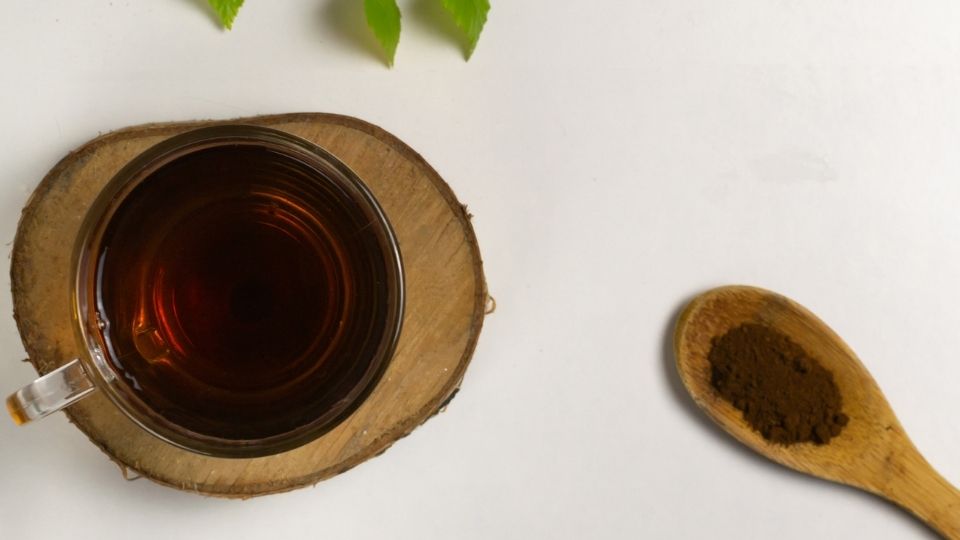
Why have Chaga mushrooms enjoyed such fame and attention throughout history? It all comes down to science.
Medicinal mushrooms contain a range of compounds that give them their unique properties. These are generally isolated and studied, either to test a hypothesis as to a compound’s role in the mushroom’s health effects or to reveal specific ways in which a given compound works.
This method has led to some interesting discoveries about how and why medicinal mushrooms like Inonotus obliquus appear to have so many benefits.
Chaga Mushroom Active Compounds
Several compounds have been associated with Chaga’s effects, and others are being investigated as potential mechanisms behind the mushroom’s power as a remedy. These include:
- Terpenoids
- Sterols
- Melanin
- Polyphenols
- Polysaccharides, most notably beta-glucans
- Oxalic, gallic, protocatechuic and p-hydroxybenzoic acids
Specific terpenoids —such as betulin, betulinic acid and inotodiol—have shown promise in scientific studies and may hold the keys to some of the most powerful benefits of Chaga mushrooms.
Why is Chaga on Birch Better?
Inonotus obliquus gets some of its beneficial compounds from the trees on which it grows.
White birch trees in particular provide a source of betulin, which winds up in the sclerotium along with the mushroom’s other food reserves. This doesn’t mean that Chaga growing on other trees has no benefits; however, the composition isn’t the same as Chaga on birch.
This also explains why “cultivated” Chaga mushrooms have largely failed in reproducing the chemistry of wild mushrooms.
To say cultivated is a bit of a stretch. Chaga that is not wild-harvested from birch trees is usually “mycelium on grain”. These Chaga substitutes contain very low levels of beneficial compounds when compared to mushrooms grown on trees- because they are mostly rice!
Chaga Mushroom Benefits
All available research on Chaga mushrooms to date has been performed in vitro (test tubes and petri dishes) or using animal models.
Although data from such studies can’t be directly extrapolated to humans, the discoveries are useful in understanding the actions of the mushroom’s compounds and how these might be harnessed to develop treatments in the future.
Chaga’s long history of use—along with significant anecdotal evidence of its benefits—suggests human trials would be beneficial.
If this “king of mushrooms” truly can do everything proponents claim, the implications for science, health and medicine are staggering.
So, what does the current science have to say about Chaga mushrooms?
1. Contains High Antioxidant Levels
Despite abundant praise from the natural health community, antioxidants still remain somewhat controversial. Scientific evidence is unclear as to whether high antioxidant levels have any actual benefits on human health.
The problem may be due in part to antioxidants being studied in isolation or in supplement form, which takes them out of context and eliminates the synergistic effects of eating whole foods.
Antioxidant activity also tends to be tested in vitro, not in people, often using much higher levels than are possible to obtain from food sources.[7]
However, high-antioxidant foods are still associated with positive health outcomes. There is some research to show Chaga in particular packs some serious protective power*.
The ORAC Value of Chaga Mushroom
ORAC—oxygen radical absorbance capacity—is a measurement of how effective a food or substance is at neutralizing free radicals in the body.[8]
Values are determined in test tube environments by observing a food’s ability to protect molecules from oxidation.
Inonotus obliquus has one of the highest ORAC values in the world.
How high is high? It’s hard to pin down the exact level, but it appears to range from 52,000 to 146,000 micromoles per 100 grams. (For comparison, acai berries have around 102,700 micromoles per 100 grams.)[9] Colder growing conditions correlate with higher ORAC values in Chaga mushrooms.
Check out our updated take on chaga and ORAC value: Does the ORAC Value of Chaga Mushroom Matter?
Protecting DNA from Damage
Oxidation occurs when free radicals damage molecules, including DNA. Damaged DNA results in cellular mutations, which can lead to premature aging and other issues if left unchecked. Some oxidation is a normal part of being alive, but external factors like poor dietary choices and environmental chemicals can put additional oxidative stress on the body—which may overwhelm natural repair mechanisms.
How might chaga mushrooms help? In one study, lymphocytes from 20 people with irritable bowel disease were treated with hydrogen peroxide to induce oxidative stress. Cells that received subsequent alcohol extract treatment had a 54.9% reduction in DNA damage compared to 34.9% in the control group*.[10]
In another study, researchers treated zebra fish embryos exposed to UV rays with chaga polysaccharides and observed a regulating effect on genes responsible for DNA repair, which reduced overall DNA damage*.[11]
Antioxidants and Anti-Aging
Because aging results from an accumulation of cell damage over time, the aging process appears to speed up when cells are exposed to dietary and environmental oxidants. It’s possible that the high antioxidant levels in chaga mushrooms could prevent this by combatting some of the most common foes of cellular health*.
It’s a hugely complex process involving DNA, RNA and other factors influencing cell division, so more studies are needed to know for sure.
However, correlations between antioxidant intake and reduced signs of aging show promise for chaga and other high-antioxidant foods as aids in the quest for healthy longevity.
2. Is chaga anti-cancer?
In Norway, Inonotus obliquus has been nicknamed kreftkjuke, the “cancer fungus.” Poles and Russians have also turned to this medicinal mushroom as cancer remedy over the years*.
So why isn’t everyone rushing off to grab some chaga as a cancer cure? Why haven’t doctors tapped into this amazing superpower and ended the “war on cancer?”
Because cancer is more complicated than that. Numerous processes are involved in both the development and treatment of cancerous conditions, and so far, no single remedy has been able to address every facet of the disease*.
Can Chaga “Cure” Cancer?
In a word: no. There is no scientific evidence to show that chaga mushrooms cure cancer.
The idea may have arisen from an old Russian story claiming that 12th-century healers were able to successfully eradicate Tsar Vladimir Monomakh’s lip tumor using the medicinal mushroom as a remedy, but this doesn’t take the place of solid research.
So, despite the claims and anecdotes, chaga mushrooms should not be considered an alternative to traditional cancer treatment. Memorial Sloan Kettering notes on its website, “To date, no clinical trials have been conducted to assess chaga’s safety and efficacy for disease prevention or for the treatment of cancer”
Chaga Mushroom Cancer Research
No human studies exist to show a correlation between chaga mushroom intake and improved cancer outcomes; so far, all studies on living organisms have been performed largely in rodent models. Some studies have examined chaga’s effects on human cancer cells in vitro, but full clinical trials are needed to determine if these effects can be replicated in actual cancer patients.
3. Supports a Strong Immune System
When it comes to immunity, reishi is usually the top pick among medicinal mushrooms.
But chaga’s betulinic acid and polysaccharide content gives it appreciable immune-boosting power, as well*.
Chaga polysaccharides may stimulate immune activity by upregulating production and expression of specific immune cells and proteins,[25] including IL-1beta and IL-6*. These proteins, known as cytokines, can act as either pro- or anti-inflammatory cytokines, suggesting Inonotus obliquus produces a modulating effect*.
Research looking at specific chaga mushroom compounds and immune reactions also shows:
- An isolated polysaccharide called IP3a can upregulate immunomodulating cytokine activity and improve the ability of macrophages (“defensive” white blood cells) to clear out invading pathogens*[26]
- Hot water extracts can reduce the expression of immunoglobulin E (IgE) in allergic reactions, as well as balance pro- and anti-inflammatory cytokines*[27]
- Water extract may be able to increase red blood cell precursors, immune cells and immune compounds in models of immunosuppression*[28]
Antiviral Properties of Chaga Mushrooms
Some studies also show chaga extracts exhibit activity against viruses, including HIV, herpes simplex and hepatitis C*.
In a study on herpes, water extract blocked the virus from fusing to cellular membranes, thereby preventing infection*.[29]
Another study using cell models of feline diseases associated with urinary tract infections and gastrointestinal problems showed similar activity. Polysaccharides from chaga were able to prevent viruses from binding with and entering cells*.[30]
Both the HIV study[31] and the study on hepatitis C[32] indicated chaga may be useful as a preventative or therapy based on results seen using cell cultures*.
4. Cools Inflammation
Although Inonotus obliquus has been shown to stimulate some types of immune activity, it also appears to modulate inflammation*.
The way chaga affects production and expression of immune cells and compounds suggests its modulatory effects prevent inappropriate inflammatory responses while allowing beneficial inflammation to occur*. Such balancing effects are the hallmark of adaptogenic foods, herbs and medicinal mushrooms*.
In the study on immunosuppression mentioned above, chaga maintained TNF-alpha levels while increasing IL-6—a prime example of the natural balancing act between pro- and anti-inflammatory activities*.
Another study examined how chaga affected mice with chemically induced colitis and showed the mushroom was able to lower levels of pro-inflammatory compounds, as well as IgE antibodies*.[33]
5. May Lower Cholesterol
High cholesterol is one of many factors that contributes to heart disease.
Oxidized cholesterol can be particularly damaging because the body may mistake it for a pathogen and unleash an immune response, resulting in inflammation that can contribute to atherosclerosis.[34]
Chaga mushroom has the potential to combat this problem by:
- Improving the way the liver transports cholesterol for better distribution and elimination, which can increase HDL (“good”) cholesterol and lower LDL (“bad”) cholesterol*[35]
- Lowering overall levels of lipids in the blood—including fatty acids, cholesterol, triglycerides and LDL cholesterol—while increasing endogenous antioxidant levels*[36]
- Offering possible protection against cholesterol oxidation via antioxidant activity*
Plant sterols, known as phytosterols, may be one mechanism behind these benefits. Wild-harvested chaga contains numerous sterols,[37] known as phytosterols.
Phytosterols’ similar shape to cholesterol means they compete for absorption in the body,[38] but unlike animal-derived cholesterol, these compounds appear to lower blood cholesterol instead of raising it*.
6. May Lower Blood Sugar
Uncontrolled or imbalanced blood sugar can signal a problem with insulin sensitivity, which is associated with both metabolic syndrome and type 2 diabetes. When blood sugar levels remain high for too long, organ and nerve damage can result.
Specific compounds in Inonotus obliquus, most notably polysaccharides, may prove to be powerful allies in the quest to prevent, control and reverse diabetes and pre-diabetic conditions*.
Researchers who administered an isolated chaga polysaccharide complex with added chromium to diabetic mice observed healing of damaged tissues, and even high doses of the complex appeared to have no toxic effect when experimentally administered to normal mice*.[39]
In another study involving rats with pancreatic damage resulting from oxidative stress, administering chaga polysaccharides over time was able to restore partial beta cell function—and therefore improve insulin production*.[40]
Chaga mushroom polysaccharides may also be able to:
- Restore balanced body composition*
- Lower fasting glucose*
- Improve glucose tolerance and insulin sensitivity*
- Make it easier for the body to move sugar from the blood to the liver for storage*
The fact that these effects were seen in diabetic mice fed high-fat diets[41] suggests chaga could be useful in addressing and correcting issues arising from poor lifestyle choices*. It’s likely the effects would be even more pronounced if the mushroom was administered as part of a regimen involving positive dietary changes*.
7. May Improve Skin and Hair Health
Chaga gets its dark exterior—and “black gold” nickname—from melanin, the same pigment that gives skin and hair its color.
While there’s no evidence to show consuming melanin affects melanin levels in skin, the compound does exhibit antioxidant properties.
In combination with this mushroom’s nutrient content, the antioxidant benefits may help protect and heal skin*. The robust amino acid profile[42] provides building blocks for proteins, which aid in repair and maintenance*. A range of vitamins and minerals complement melanin to provide support for healthy skin. (For more on this, see “Is Chaga a ‘Superfood?'” below.)
A study investigating the effect of pre-treating cells with chaga mushroom showed protection against premature cell death and UV damage, including “skin thickening and wrinkle formation,” suggesting potential anti-aging properties*.[43]
Interestingly, one study on human follicle dermal papilla cells—involved hair’s growth cycle—showed chaga extract fractions promoted activity that could stimulate new hair production*.[44] It’s not surprising, then, that chaga mushroom is a traditional shampoo ingredient in Mongolia and now appears in a range of other skin and hair products around the world.
Will Chaga Help Psoriasis?
Chaga soaps and creams are gaining popularity, but concrete scientific evidence doesn’t yet exist to determine whether they work to improve skin conditions like psoriasis.
One Russian study did show chaga extract was about to heal psoriasis in patients with chronic inflammatory GI issues after nine to 12 weeks of consistent supplementation*.[45]
Unfortunately, the study wasn’t well controlled, and there’s no way to know if the improvement in psoriasis was a direct effect or a result of simultaneous improvements in GI function.
8. Calms Digestive Disorders
A firm belief in chaga mushroom’s ability to address digestive problems has prompted Russia to license an alcohol extract product called Befungin for the treatment of stomach and intestinal disorders*.
Research shows they may be on to something.
Chaga contains antimicrobial melano-glucan complexes, and melanin itself appears to boost beneficial gut bacteria[46] while reducing populations of microbes that thrive in pro-inflammatory environments*.[47]
Taken together, these actions have the potential to help with dysbiosis, an unhealthy imbalance in gut microflora that can accompany or lead to a range of digestive conditions*.
Chaga may also keep bad gut bacteria in check by decreasing levels of TNF-alpha and TGF-beta—both of which are involved in inflammation—while increasing antioxidant capacity*.
In a study on mice with chronic pancreatitis, these changes occurred along with a reduction in lipase and increases in glutathione peroxidase (GSH), which breaks down oxidized lipids*.[48]
Simultaneous improvements in gut microbiome composition suggest a correlation between chaga’s anti-inflammatory and antioxidant activities and better gut health*.
What’s more, chaga polysaccharides were shown to exhibit beneficial effects as they were broken down into monosaccharides in a simulated model of human digestion*.[49] Antioxidant activity fluctuated depending on the stage of digestion, but inhibitory effects on carbohydrate breakdown increased, pointing to a possible mechanism behind why this mushroom may improve blood sugar levels.
Other studies have shown chaga mushroom exhibits antiulcer activity without any signs of toxicity[50] and may help prevent pancreatic cell destruction in chronic pancreatitis*.[51]
9. Has Positive Effects on Mood and Cognition
Inflammation is increasingly being cited as a possible contributor to neurological disorders like depression and dementia. In Alzheimer’s, for example, inflammatory processes have been linked to the buildup of the “junk” proteins characteristic of disease progression; all other types of dementia also appear to involve inflammation in the brain, known as neuroinflammation*.[52]
Additionally, people suffering from depression tend to exhibit increased immune activity,[53] which suggests immunomodulation could lead to better overall mental health*.
Where does chaga mushroom come into all this? Mouse studies have shown it may:
- Improve cognition*
- Reduce activity related to beta-amyloid protein deposit formation*[54]
- Improve learning and memory*[55]
These effects have the potential to keep mental activity sharp as people age, as well as improve quality of life for those suffering from specific neurological problems*.
Stress, Anxiety and Chaga Mushrooms
What about the almost universal plague of stress? The adaptogenic characteristics of Inonotus obliquus may be able to help there, too.
Adaptogens are associated with lower stress and better balance both mentally and physically*.
They appear to work by helping the body adapt to emotional and environmental stressors and maintain the harmonious internal balance known as homeostasis*.[56,57] Many medicinal mushrooms provide these benefits—without the unpleasant side effects of prescription stimulants and depressants*.
Because adaptogens can improve mental performance and increase stamina, chaga mushrooms may also improve focus in times of heightened stress or provide a boost when sluggishness hits*.[58]
10. Could Increase Endurance
Only one study exists to show a potential connection between chaga intake and exercise endurance*. In it, researchers divided 64 mice into four groups of 16 and administered polysaccharides at doses of zero, 100, 200 and 300 milligrams per kilogram across the groups every day for 14 days.[58]
At the end of the study, eight mice from each group were given an endurance swimming test in which they swam while carrying an added weight amounting to 5% of their body weights. The mice that got the chaga were not only able to swim longer but also produced less lactic acid and urea nitrogen and had higher levels of glycogen in their livers and muscles*. (The other eight mice, acting as controls, swam for 30 minutes.)
What does it all mean? Polysaccharides from chaga appear to have allowed the mice to extend their swimming times without using up as much stored fuel or creating as many metabolic byproducts as the control mice*. And none of the mice in the polysaccharide groups experienced any toxicity from the treatment*.
If these results could be duplicated in future studies (preferably on humans), chaga may join cordyceps as a new superhero mushroom for athletes*!
11. May Relieve Pain
Because pain and inflammation often go together, Inonotus obliquus offers promise in addressing conditions in which pain is a prominent symptom*.
One way chaga mushrooms may reduce pain is by inhibiting pro-inflammatory pathways and affecting nuclear factor kappa B (NF-kB) binding, thereby positively regulating the way the body reacts in inflammatory conditions*.[59]
Rheumatoid arthritis provides a good model for chaga’s potential use in pain management.
In this autoimmune disease, pro-inflammatory cytokines are elevated to the point where the body’s natural anti-inflammatory processes can’t overcome them effectively*.[60]
The mushroom’s modulating effects on a number of pro- and anti-inflammatory cytokines—as well as nitric oxide, which can reduce or prevent sensations of pain[61]—make it a candidate for further study in this area*.
12. Offers Potential Liver Protection
Studies on chaga and liver health are limited, but there are some that stand out:
- Researchers tested the effectiveness of polysaccharides against liver injury in mice resulting from a parasitic infection. The polysaccharides reduced pro-inflammatory compounds, decreased markers of liver damage and increased levels of superoxide dismutase (SOD) and glutathione (GSH)—both powerful antioxidants*.[62]
- In a study of rats with oxidative liver injury, a low concentration of chaga mushroom water extract reduced the release of compounds associated with damaged liver cells*. Levels of malondialdehyde, a marker of oxidative stress, also came down*.[63,64]
Is Chaga a “Superfood?”
The term “superfood” has been used so often as a marketing gimmick that it’s starting to become nebulous and suspect. When it comes to chaga, though, the science suggests this medicinal mushroom could be even more super than other so-called superfoods!
Why? In addition to its active compounds and a wide range of phytonutrients, chaga mushroom is also a source of:[65]
- B-complex vitamins
- Vitamin D
- Fiber
- Calcium
- Copper
- Iron
- Magnesium
- Manganese
- Potassium
- Zinc
Many of these nutrients are key players in some of the body’s most important functions—particularly zinc, which is required for over 100 enzymatic processes throughout various organ systems.
The full range of nutrients is also beneficial for bone health, immune activity, heart health and proper muscle function*.
Chaga’s rock-hard texture means it will never find a place among culinary mushrooms, but its benefits are readily available from high-quality supplements.
How Chaga Mushroom Grows
Anyone wondering where to find the wonderfully bizarre Inonotus obliquus sclerotium should look to nature first. So far, both science and tradition point to birch trees as the best source for specimens with a full complement of beneficial compounds.
“Cultivation” methods using mycelium on grain haven’t been able to produce chaga with the same level or balance of compounds as mushrooms growing in the wild.
Therefore, the best way to get access to the benefits is to pull on some hiking boots and hit the deep woods (or purchase some chaga chunks from a local forager).
Chaga Conk Formation
To people whose main exposure to mushrooms is the “cute” button variety at the grocery store, the way chaga forms on trees may seem almost horrifying. But it’s a perfectly natural process with a rather unusual twist.
It starts with an unhealed gap or “wound” in the bark of a tree. These gaps are prime real estate for any chaga spores traveling through the area. Once they take up residence, the spores begin to develop into a full mushroom from inside the tree. The parasitic process causes heart rot, which literally eats away at the heartwood over time.
Trees with visible chaga formations may appear healthy until the heart rot becomes more invasive. This is because the decay remains concentrated around the sclerotium at first but can eventually spread throughout the tree, causing it to die.[66]
The Reproductive Cycle of Chaga Mushrooms
Inonotus obliquus won’t reproduce until heart rot has set in on the host tree—and when it does, things just get weirder.
Most mushrooms flaunt their fruiting bodies out in the open as brackets, stems and caps or funky cascades of hair-like tubes, but chaga’s fruiting body tucks itself away underneath the tree’s bark and rarely sees the light of day. This strange “inside-out” growing process is another unique feature setting this mushroom apart from the rest of the fungal kingdom.
Instead of a classic mushroom structure, the fruiting body consists of a network of tubes that house chaga spores while they mature. When the tree dies, the fruiting body releases spores into the air, where they travel to nearby trees to start a new lifecycle.
Not much is known about how chaga sporulation works, but whether or not the trunk remains standing, the host tree’s bark is always split in the process.
Chaga Fruiting Body
Though it’s not as easily identifiable as the hard, dark sclerotium, the fruiting body of a chaga mushroom does have some distinguishing characteristics. It consists of thin layers, which can be white, gray or brown and features a lengthy network of pores.
True to its scientific name, chaga’s pores begin to form above the sclerotium and angle slightly upward (hence “obliquus“). This tubular structure puts the mushroom in the polypore category with other fungi that rely on pores instead of gills for spore release.
The porous tubes in any given fruiting body can be up to four meters (about 13 feet) long and 50 centimeters (about 19.6 inches) wide and may take one to two years to form.
Chaga products listing “fruiting body” as an ingredient don’t actually contain the mushroom’s fruiting body. However, the term may be used to distinguish wild mycelial sclerotia from mycelium cultivated on grain.
What Are the Side Effects of Chaga?
Natural remedies aren’t free from side effects. Just like regular medications, any medicinal mushroom or natural product has the potential to cause unwanted symptoms.
However, most people tolerate Inonotus obliquus well at typical supplemental doses*. Taking too much may cause stomach upset, digestive discomfort or diarrhea.
Precautions
Because chaga mushrooms haven’t been tested in human clinical trials, no side effects have been officially documented. However, there are a few important precautions to keep in mind:
- Until there are trials to show it’s safe, women who are pregnant or breastfeeding should avoid supplementing.
- People with mushroom or mold allergies may experience reactions.
- The high oxalate content may make the mushroom unsuitable for people with liver or kidney problems, particularly kidney stones. In one case, a 72-year-old Japanese woman suffered acute kidney injury from ingesting 4 to 5 teaspoons of chaga powder per day for six months, far in excess of the recommended dose.[67]
The biggest consideration of all is to be sure that what looks like chaga is actually chaga! When foraging for birch-grown sclerotia, cut off a small piece of the mass to check for the telltale orange interior. If it’s not there, it’s probably not the right mushroom.
Chaga Supplement Interactions
Due to some of the effects chaga mushrooms exhibit in in vitro and animal studies, it’s best to pass on supplementation when:
- Taking antiplatelet or anticoagulant medications
- Suffering from a bleeding disorder
- Planning to have surgery
- Taking hypoglycemic drugs
- Dealing with an autoimmune condition
Use caution when taking chaga in combination with other herbal supplements, especially those used to address similar health concerns.
Is Chaga Psychoactive?
Nope. Chaga mushrooms are considered adaptogens and immunomodulators and may have a positive effect on mood, but they’re far from trippy.
All of their “magic” comes from non-psychoactive compounds that balance and boost body systems—no magical mystery tour required.
How to Harvest and Prepare Chaga Mushrooms
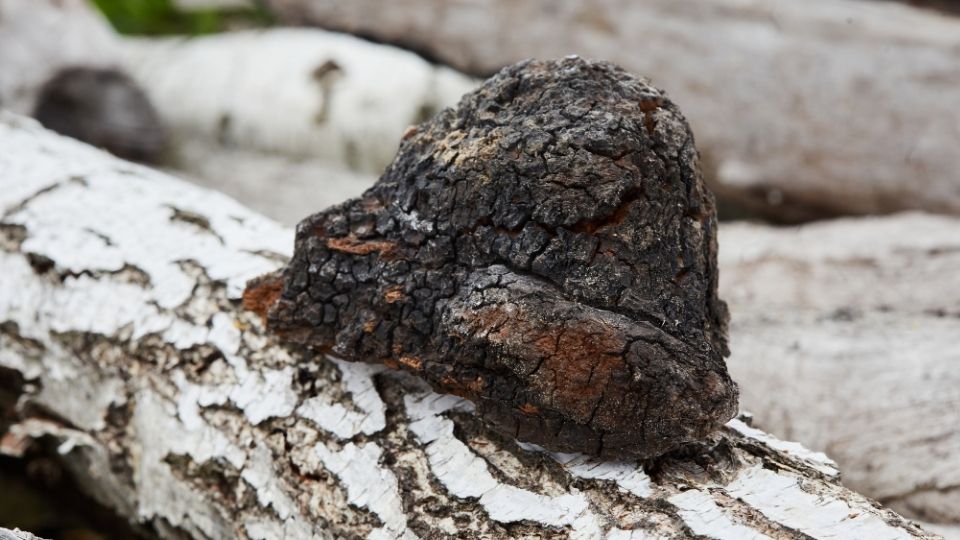
Enthusiastic mushroom hunters say the best way to harvest chaga is to hit the woods in the coldest months of the year. The lack of foliage makes sclerotia easier to spot, but getting them off trees may be a challenge if the masses are frozen!
Although these powerful mushrooms can be found on a variety of hardwoods, focusing on birch trees has two benefits:
- Chaga on birch is the most common, so confusing it with other fungi or deformities is less likely
- Birch-grown chaga appears to offer the most benefits
A sclerotium is always darker in color than the host tree, while burls and other deformities are usually the same color as the bark. And it almost goes without saying (but is important enough to say anyway): When in doubt, don’t harvest or consume!
Harvesting Chaga Conks Safely and Sustainably
Sustainable harvesting is a big deal in the foraging community, and for good reason. Walking into the woods and hacking a hunk of chaga off a birch tree with no regard for the tree’s health or the lifecycle of the mushroom can damage both organisms and rob other people of the chance to experience the mushroom’s benefits.
Inonotus obliquus takes three to five years to fully form, so the smartest thing to do is harvest only what will be used and leave the rest. This requires a sharp blade—like a knife, hatchet or axe—and a good deal of care to avoid harming the tree. In some cases, it’s possible to separate the sclerotium from the tree by hand, but this method makes it more difficult to take smaller pieces.
Will Chaga Grow Back?
A good rule of thumb is to leave at least one-third of the sclerotium behind to ensure more remains available to other foragers. Avoid harvesting from small chaga mushroom formations; instead, look for large, mature mushrooms further along in the growth process.
But regrowth isn’t the only reason for partial harvesting. Detaching the entire sclerotium can leave an open hole in the host tree’s trunk, making it susceptible to other diseases and further damage. So be smart and courteous when gathering chaga mushrooms!
Why Dry Chaga?
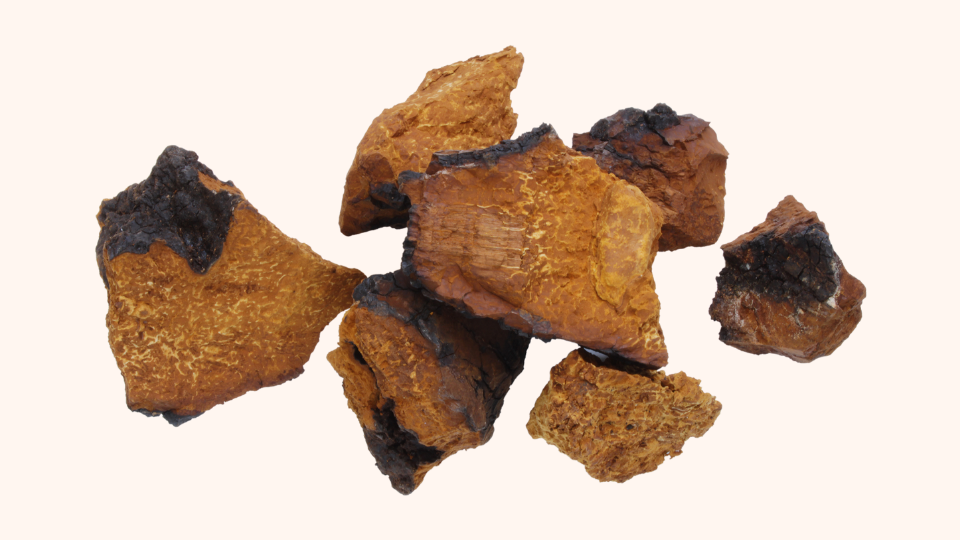
Right after coming off the tree, a chaga sclerotium feels like cork. It’s not unusual for the orange interior to be spongy; that’s a sign there’s water in the mushroom, which needs to be removed before storing.
Why? Because moisture can quickly become an invitation for mold. And moldy chaga is bad chaga, fit only for the trash. Drying the mushroom helps it avoid this unfortunate—and sad!—fate.
Of course, fresh chaga can be used immediately to make tea or tincture. Drying is only required when preserving chunks for later.
To prepare the sclerotium for drying, clean to remove debris and break it down into smaller chunks. (This may require putting it in a towel or cloth bag and using a hammer to break it apart.) Dry the chunks using one of two methods:
- Let sit indoors in a warm, dry area for up to eight weeks
- Place in a dehydrator or oven at 110°F to 112°F (43°C to 49°C) for around 24 hours
Make sure the chaga is completely dry before storing in an airtight container.
Chaga Mushroom for Sale: How to Choose a Chaga Supplement
Not everyone has the time to go foraging for Inonotus obliquus in the wild. Supplements are a convenient alternative as long as they come from a reputable source.
Here’s how to find a chaga mushroom supplement that has all the benefits that make this mushroom so famous.
What’s the Best Chaga Mushroom Extract?
Research suggests the water- and fat-soluble compounds in chaga—polysaccharides and terpenes—may both have positive effects on health*. So, taking either water or alcohol extract should provide beneficial compounds*. (Chaga tea, after all, is pretty much a water extract, and people have been singing its praises as a tonic for thousands of years!)
Dual extraction, which combines water and alcohol extracts in one product, delivers the highest concentrations of beneficial compounds. However, the quality of the supplement also matters. A dual-extracted powder from chaga mycelium cultivated on grain and touted as “high polysaccharide” may be more grain than mushroom and offer few to no benefits.
Is Wild Chaga Really Better than Cultivated?
Some research suggests cultivated chaga mushrooms do exhibit some beneficial effects. One study of mycelium was grown on brown rice showed a measure of antioxidant activity and anti-inflammatory properties, but the researchers apparently didn’t compare this to wild-harvested chaga.[69] Another study confirmed the possibility that rice-grown mycelium may exhibit anti-inflammatory activity*.[70]
While it’s understandable that people want to find a way to bring chaga’s benefits to a wider audience, the science doesn’t yet show that cultivated forms deliver the same level of health-boosting compounds.
Chaga Tincture vs. Capsules vs. Powder
Properly extracted chaga supplements are beneficial in any form. The best option differs according to personal needs and tastes:
- Tinctures are quick and easy to take but can leave an alcohol aftertaste
- Powders add an earthy flavor to beverages and foods
- Capsules are flavorless but not suitable for people who have difficulty swallowing pills
As with any medicinal mushroom supplement, content matters more than form! Choose chaga that comes from a clean source—and avoid powder or capsules with added fillers.
Where to Buy Chaga Mushroom
Look for quality over price when searching for supplements. Some companies, like FreshCap, have their products tested to confirm levels of compounds like beta-glucans, which can be helpful when comparing options.
Before making a purchase, read reviews. Research company reputations. Ask how the mushrooms are grown and the supplements are made. If anything seems sketchy, move on!
Chaga chunks for tea can be sourced from reputable foragers. Don’t know where to find one? Look for a local mycological society, or check out nearby natural food stores and co-ops for locally harvested specimens*.*
Using Chaga Supplements for Health
Ready to give the “king of mushrooms” a try? The benefits may not be felt right away, but consistently incorporating chaga capsules, powder or tea into a daily routine can deliver results over time.
To stick with a regimen, choose a supplement form that’s convenient to take and easy to incorporate into existing health routines.
How Much Chaga to Take
A good starting point for chaga supplementation is about 1 gram of dual-extracted powder or the equivalent in capsule form. (Check product labels for the recommended dose.)
When drinking chaga tea, aim for one to two 6-ounce cups per day. Don’t exceed three 6-ounce cups, or side effects may result.
Chaga tincture can be taken in 2 to 3 milliliter doses two to five times per day. Spread multiple doses of tea or tincture throughout the day.
Start with the smallest dose and work up to larger amounts until the desired effect is achieved. Remember to be consistent! Sometimes “unseen” benefits—like reduced inflammation or enhanced immunity—aren’t as obvious right away and can only be noticed after taking a break from routine supplementation.
When to Take Chaga Supplements or Drink Chaga Tea
Any time of day is a good time to supplement with chaga or enjoy a chaga-infused beverage—unless it’s caffeinated, in which case it’s smarter to have it earlier in the day. Taking this mushroom in the morning can also bring balance to the day thanks to its adaptogenic properties.
Taking a supplement at night, on the other hand, can aid in getting a more restful sleep, particularly when consumed as a warm, comforting tea!
And, of course, taking chaga mushrooms regularly—regardless of the time of day—may support stronger immunity and protect against seasonal illness*.
Chaga Mushroom Recipes: How to Eat Chaga
While nobody would actually want to eat a **chaga mushroom—the sclerotium far too hard for that—there are plenty of tasty ways to enjoy this unusual mushroom.
What does chaga taste like? In many ways, the flavor is similar to the appearance: earthy and dark with a deepness reminiscent of coffee but without bitter overtones. It’s a classic “mushroom” flavor with loads of rich umami!
How to Make Chaga Tea
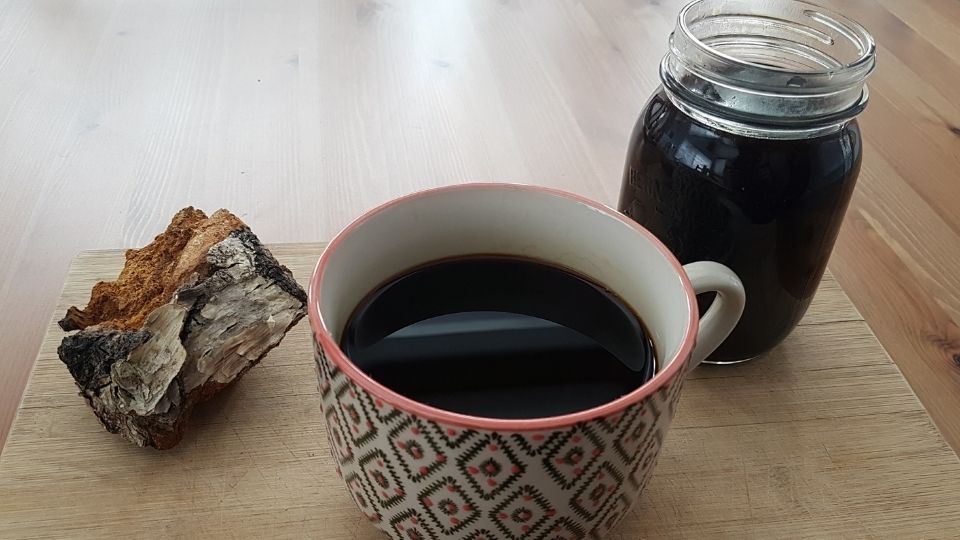
One of the most accessible ways to add chaga to a daily routine is to make chaga mushroom tea. While its possible to purchase pre-prepared chaga tea bags, making the tea from chunks isn’t difficult—and it helps ensure the mushrooms come from a reliable source.
To make tea from chaga chunks:
- Obtain chaga mushroom chunks online or harvest some in the wild.
- Wrap about 3 ounces of the chunks in towel.
- Place the bundle on a hard surface that isn’t easily damaged, and use a hammer to smash the chunks into small pieces.
- If desired, grind the resulting bits into a powder using a strong blender or mortar and pestle. (Warning: Do not use a coffee grinder—chaga is so hard, it’s likely to break the blade!)
- Add the pulverized chunks to 2.5 to 4 liters (about 10.5 to 17 cups) of water, bring to a boil and reduce the heat to a low simmer.
- Simmer the mixture for 3 to 4 hours, or until the mushroom bits sink.
- Strain the liquid through a tea towel, nut milk bag, fine mesh strainer or coffee filter, and store the tea in jars in the fridge.
A quick and lazy alternative (no hammer required): ****Place the chaga chunks and water in an Instant Pot or slow cooker and cook on low for 6 to 8 hours.
Chunks can be reused for three to four batches of tea, although subsequent batches may require a longer cooking time.
Making tea from chaga mushroom powder:
- Add 1 gram of chaga powder to a cup.
- Boil about a cup of water.
- Combine the water with the powder, mix it up and enjoy!
Note that this only works with chaga powder that’s been through a proper extraction process. Simply mixing ground chaga with water isn’t enough to draw out the beneficial compounds and make them available for the body to use.
What About Chaga Mushroom Coffee?

Chaga can be a great coffee substitute for people looking to cut down on caffeine without losing the rich, deep flavor of their daily cup of joe.
For everyone else clutching their coffee cups and vowing never to cross over to the caffeine-free dark side, it’s easy to make chaga mushroom coffee at home by adding about a gram of chaga powder or combining prepared chaga tea and strong coffee in the same cup.
Drinking chaga and coffee together probably won’t enhance the mushroom’s beneficial effects, but it can help power up the day with an extra antioxidant boost!
Be cautious when considering commercially prepared mushroom coffee drinks and mixes. Some mixes contain additional ingredients, such as sweeteners, which add empty calories and make the beverages less healthful. In some cases, the quality of the coffee is poor and makes the whole drink less than satisfying. Low-quality coffee may also be a red flag for an overall low-quality product.
Other Tasty Chaga Mushroom Drinks
Not satisfied with simple chaga mushroom coffee? Chaga powder can be added to a variety of inventive drinks to deepen the flavor and infuse the mixture with added health benefits.
Try these delicious ways to turn medicinal mushrooms into treats:
Baking and Cooking with Chaga
Chaga mushroom powder is versatile enough to use in other recipes, including desserts, baked goods and even savory dishes. Here are a few FreshCap recipes for inspiration:
- Almond Butter Stuffed Chaga Chocolates (Makes great gifts!)
- Chaga Mushroom Brownies (Gluten free!)
- Chaga Summer Rolls (Includes a plant-based option!)
Of course, it doesn’t have to stop there—feel free to get ambitious and try chaga in any dish that could benefit from a burst of ‘shroomy umami!
Feel the Chaga Mushroom Difference
Whether you brew up a tea, mix some powder in your coffee or add capsules to your supplement regimen, chaga has the potential to transform your health routine. Remember to check with your doctor before supplementing if you have any health conditions or are taking prescription medications.
Otherwise, chaga’s low incidence of side effects make it a safe medicinal mushroom to experiment with. Try it, and see how it makes you feel. You might just find yourself getting sick less, performing better and even feeling happier as you go about your day!
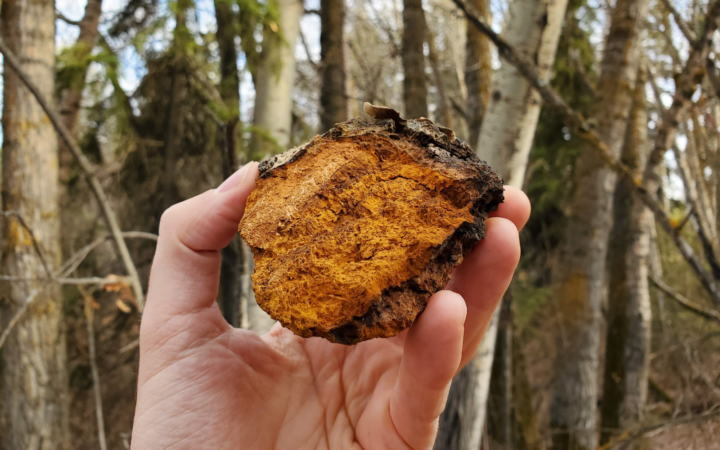
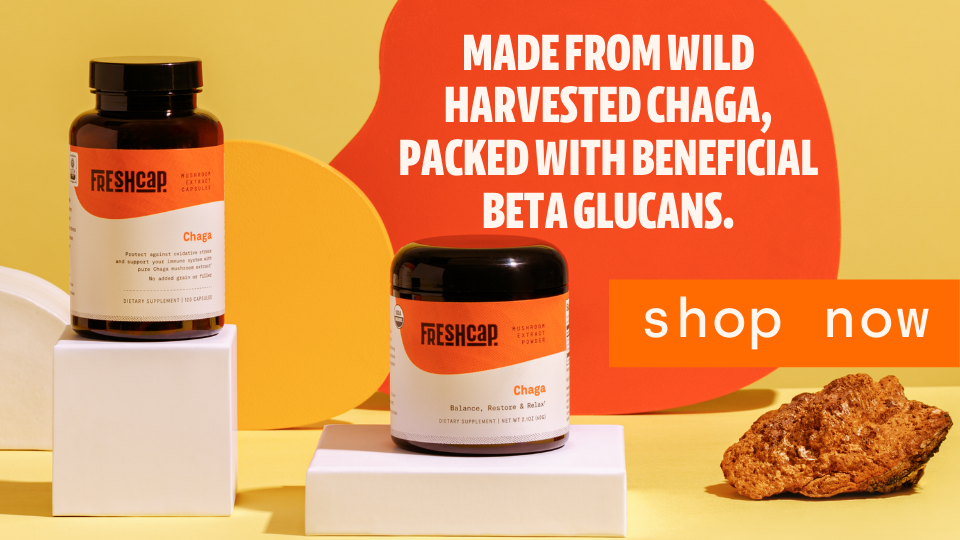
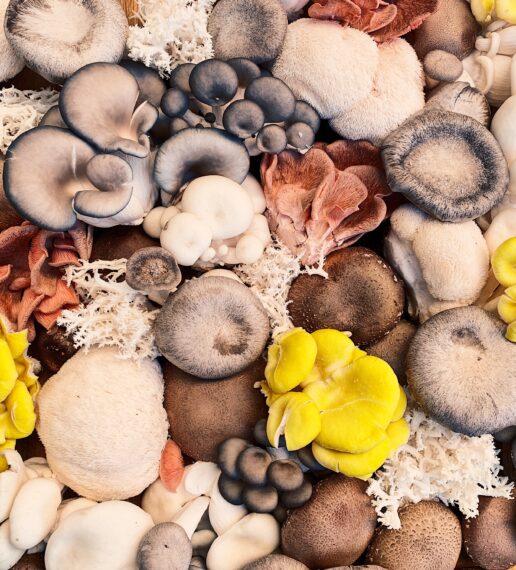

Thank you!
I have a bag of Serbian chaga mushroom wildcraft how do u preserve it.
How do u preserve the tea n raw chunck of chaga mushroom wild raft?
Extremely great information Tony. Probably the best guide I’ve found on Chaga thus far.
I’d love to link to this content and your home page.